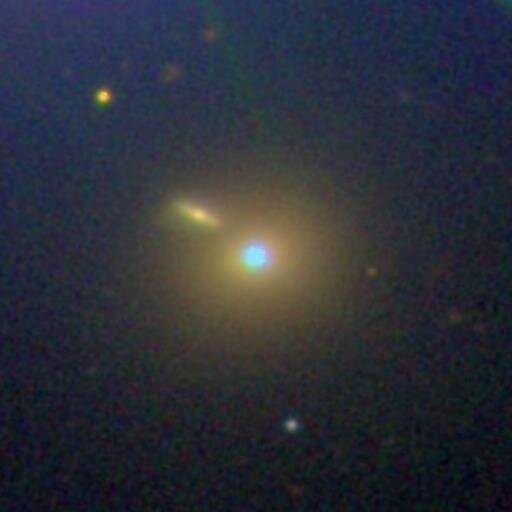Sloan Digital Sky Survey image of Mrk 421. Credit: Sloan Digital Sky Survey.
By analyzing the data from ESA's XMM-Newton satellite, astronomers from the Astronomical Observatory of the Jagiellonian University in Kraków, Poland, and elsewhere, have investigated X-ray intraday variability of a nearby blazar known as Markarian 421. Results of the study, published June 5 on arXiv.org, could help us better understand the nature of high-energy X-ray sources.
Blazars are very compact quasars associated with supermassive black holes (SMBHs) at the centers of active, giant elliptical galaxies. They belong to a larger group of active galaxies that host active galactic nuclei (AGN), and are the most numerous extragalactic gamma-ray sources. Their characteristic features are relativistic jets pointed almost exactly toward the Earth.
Based on their optical emission properties, astronomers divide blazars into two classes: flat-spectrum radio quasars (FSRQs) that feature prominent and broad optical emission lines, and BL Lacertae objects (BL Lacs), which do not.
At a distance of some 134 million light years, Markarian 421 (or Mrk 421 for short) is one of the nearest blazars to Earth. Previous observations of Mrk 421 classified it as a BL Lac due to its featureless optical spectrum, compact radio emission, strongly polarized and variable fluxes in optical and radio bands. The blazar hosts a central SMBH with a mass estimated to be between 200 and 900 million solar masses.
Mrk 421 is also classified as a high-energy peaked blazar (HBL) given that its synchrotron peak in the spectral energy distribution (SED) was found in X-ray energies higher than 0.1 keV. This, together with its featureless non-thermal spectrum, make Mrk 421 a good candidate to study intraday flux and spectral variations over time. So a team of astronomers led by Angel Priyana Noel analyzed its X-ray observations spanning 17 years.
"We utilize public archive data of 25 pointed observations of Mrk 421 with an EPIC-pn instrument on board of XMM-Newton carried out within a period of 17 years (2000–2017) for analysis of flux and spectral variations on IDV [intraday variability] timescales and to study the X-ray emission tentatively expected to be generated in the jet close to the central black hole of the blazar," the researchers explained.
In general, the available EPIC-pn data allowed the team to carry analysis of flux variability, spectral variability, and cross correlated studies of soft and hard X-ray bands of Mrk 421 on IDV timescales. For all the pointed X-ray observations, they inspected light curves in soft (0.3–2.0 keV), hard (2.0–10.0 keV), and total (0.3–10.0 keV) energy bands.
The study found that the fractional variability displays clear evidence of large amplitude IDV in 23 out of 25 pointed observations in all considered X-ray bands. The IDV duty cycle was estimated to be 96%, however some level of variability was also identified in all data.
Furthermore, the results suggest that the fractional variability amplitude depends on the studied X-ray energy range and is always higher in the hard band than in the soft band. The total energy weighted minimum variability timescales for all pointed observations occur in the range from 1,030 to 1,059 seconds.
The researchers also identified time lags between soft and hard energy bands, but they do not reveal any constant pattern. They added that the occurrence of the big lags in soft or hard photons is moderately related to the degree of flux variability.
More information: A Priyana Noel et al, X-ray intraday variability of the TeV blazar Mrk 421 with XMM-Newton. arXiv:2206.02159v1 [astro-ph.HE], arxiv.org/abs/2206.02159
© 2022 Science X Network
























